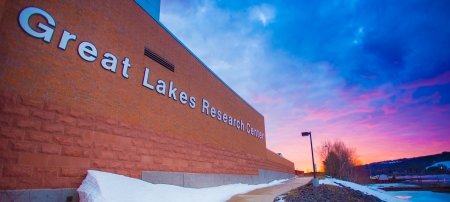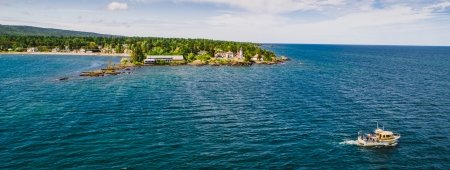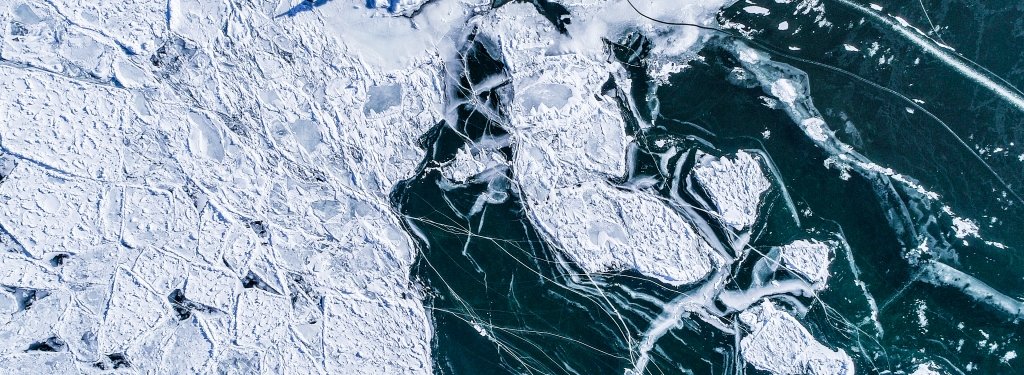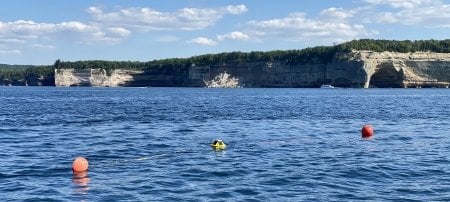New Ballast Treatment Could Help Shield Lake Superior from Deadly Fish Disease
Michigan Technological University professor has developed a new water treatment that could help keep a deadly fish disease out of Lake Superior.
David Hand, a professor of civil and environmental engineering at Michigan Tech, has devised a simple way to treat ballast water in vessels ranging from pleasure craft to ore boats. His method is designed to kill the virus that causes viral hemorrhagic septicemia (VHS), an often-fatal disease that has been attacking fish populations in the lower Great Lakes.
Hand's treatment is simple. The ballast water is disinfected with sodium hypochlorite—ordinary household bleach. Then it is treated with ascorbic acid, or vitamin C, which neutralizes the bleach before the water is released into the lake.
With good initial results, Hand has tested his method on the Ranger III, a National Park Service vessel that shuttles visitors and staff between the mainland and Isle Royale National Park.
In the next few weeks, the Great Ships Initiative will conduct independent lab tests on his system at the University of Wisconsin–Superior to help determine if it is safe, effective and inexpensive. Other partners in the effort are the National Park Service and the US Fish and Wildlife Service.
"VHS has had a devastating effect on the musky population in Lake St. Clair and affects 23 species of game fish," said Phyllis Green, superintendent of Isle Royale National Park and the midwest coordinator of the park service's VHS Prevention Team. "It's important that we keep it out of the Lake Superior basin or at least slow its spread. Our aim is to find a low-tech, low-cost, interim solution that can stop the spread of VHS."
Since 2003, VHS it has caused massive dieoffs of fish species ranging from walleyes to salmon in all of the Great Lakes except Superior. Infected fish die from bleeding of their internal organs and often have open sores and bruised-looking, reddish tints on their skin.
As bad as it is, VHS is only part of the problem Hand wants to address. Exotic species have been hitchhiking throughout the Great Lakes via ballast tanks since 1959, when the St. Lawrence Seaway opened. And, as global trade increases, the problem will only get worse.
"Ships unload their ballast water from all over the world, and with it all kinds of exotic, invasive species, from viruses and bacteria to the zebra mussel," said Hand.
It's unfair to point the finger only at ocean-going ships, says Hand, a devoted angler and boat owner himself. All boaters should sterilize their bilge, ballast and livewell water.
"Not only do we need to prevent the salties from bringing in new viruses, we also need the lake carriers from the lower Great Lakes to treat their ballast, because the VHS virus is already in Lakes Huron, Michigan and Erie, and we don't want it in Superior," he said. "We really need something for all ships, as well as pleasure boats."
"We all need to protect the resource," he said.
If tests show that his system is as safe and effective as he believes, Hand hopes to map a strategy to implement its use throughout the Great Lakes.
The Great Ships Initiative is a public-private collaborative that aims to halt the ship-driven spread of exotic species through the Great Lakes and the St. Lawrence Seaway. In addition to conducting research and development on possible ballast treatment systems, the Great Ships Initiative supports harbor monitoring and develops financial incentives to encourage ballast treatment and to protect the Great Lakes ecosystem.04
Michigan Technological University is a public research university founded in 1885 in Houghton, Michigan, and is home to more than 7,000 students from 55 countries around the world. Consistently ranked among the best universities in the country for return on investment, Michigan’s flagship technological university offers more than 120 undergraduate and graduate degree programs in science and technology, engineering, computing, forestry, business and economics, health professions, humanities, mathematics, social sciences, and the arts. The rural campus is situated just miles from Lake Superior in Michigan's Upper Peninsula, offering year-round opportunities for outdoor adventure.




Comments